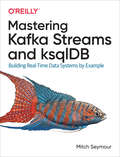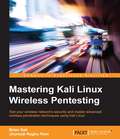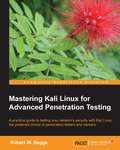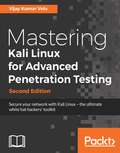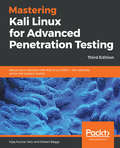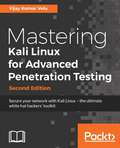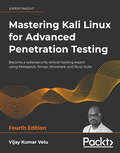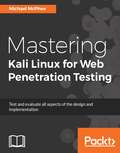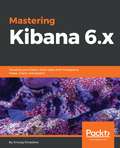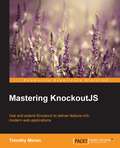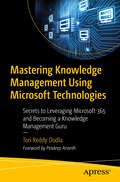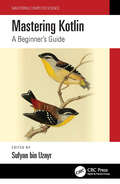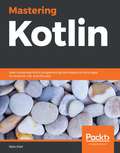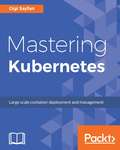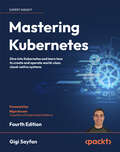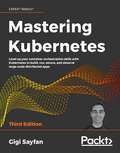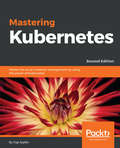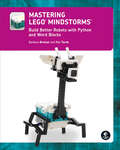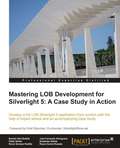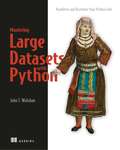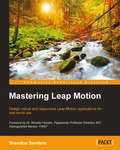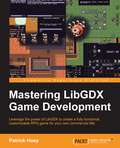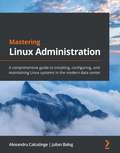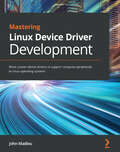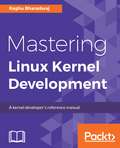- Table View
- List View
Mastering Kafka Streams and ksqlDB: Building Real-time Data Systems By Example
by Mitch SeymourWorking with unbounded and fast-moving data streams has historically been difficult. But with Kafka Streams and ksqlDB, building stream processing applications is easy and fun. This practical guide shows data engineers how to use these tools to build highly scalable stream processing applications for moving, enriching, and transforming large amounts of data in real time.Mitch Seymour, data services engineer at Mailchimp, explains important stream processing concepts against a backdrop of several interesting business problems. You'll learn the strengths of both Kafka Streams and ksqlDB to help you choose the best tool for each unique stream processing project. Non-Java developers will find the ksqlDB path to be an especially gentle introduction to stream processing.Learn the basics of Kafka and the pub/sub communication patternBuild stateless and stateful stream processing applications using Kafka Streams and ksqlDBPerform advanced stateful operations, including windowed joins and aggregationsUnderstand how stateful processing works under the hoodLearn about ksqlDB's data integration features, powered by Kafka ConnectWork with different types of collections in ksqlDB and perform push and pull queriesDeploy your Kafka Streams and ksqlDB applications to production
Mastering Kali Linux Wireless Pentesting
by Jilumudi Raghu Ram Brian SakTest your wireless network's security and master advanced wireless penetration techniques using Kali Linux About This Book * Develop your skills using attacks such as wireless cracking, Man-in-the-Middle, and Denial of Service (DOS), as well as extracting sensitive information from wireless networks * Perform advanced wireless assessment and penetration tests * Use Embedded Platforms, Raspberry PI, and Android in wireless penetration testing with Kali Linux Who This Book Is For If you are an intermediate-level wireless security consultant in Kali Linux and want to be the go-to person for Kali Linux wireless security in your organisation, then this is the book for you. Basic understanding of the core Kali Linux concepts is expected. What You Will Learn * Fingerprint wireless networks with the various tools available in Kali Linux * Learn various techniques to exploit wireless access points using CSRF * Crack WPA/WPA2/WPS and crack wireless encryption using Rainbow tables more quickly * Perform man-in-the-middle attack on wireless clients * Understand client-side attacks, browser exploits, Java vulnerabilities, and social engineering * Develop advanced sniffing and PCAP analysis skills to extract sensitive information such as DOC, XLS, and PDF documents from wireless networks * Use Raspberry PI and OpenWrt to perform advanced wireless attacks * Perform a DOS test using various techniques and tools In Detail Kali Linux is a Debian-based Linux distribution designed for digital forensics and penetration testing. It gives access to a large collection of security-related tools for professional security testing - some of the major ones being Nmap, Aircrack-ng, Wireshark, and Metasploit. This book will take you on a journey where you will learn to master advanced tools and techniques to conduct wireless penetration testing with Kali Linux. You will begin by gaining an understanding of setting up and optimizing your penetration testing environment for wireless assessments. Then, the book will take you through a typical assessment from reconnaissance, information gathering, and scanning the network through exploitation and data extraction from your target. You will get to know various ways to compromise the wireless network using browser exploits, vulnerabilities in firmware, web-based attacks, client-side exploits, and many other hacking methods. You will also discover how to crack wireless networks with speed, perform man-in-the-middle and DOS attacks, and use Raspberry Pi and Android to expand your assessment methodology. By the end of this book, you will have mastered using Kali Linux for wireless security assessments and become a more effective penetration tester and consultant. Style and approach This book uses a step-by-step approach using real-world attack scenarios to help you master the wireless penetration testing techniques.
Mastering Kali Linux for Advanced Penetration Testing
by Robert W. BeggsThis book provides an overview of the kill chain approach to penetration testing, and then focuses on using Kali Linux to provide examples of how this methodology is applied in the real world. After describing the underlying concepts, step-by-step examples are provided that use selected tools to demonstrate the techniques.If you are an IT professional or a security consultant who wants to maximize the success of your network testing using some of the advanced features of Kali Linux, then this book is for you. This book will teach you how to become an expert in the pre-engagement, management, and documentation of penetration testing by building on your understanding of Kali Linux and wireless concepts.
Mastering Kali Linux for Advanced Penetration Testing - Second Edition
by Vijay Kumar VeluA practical guide to testing your network's security with Kali Linux, the preferred choice of penetration testers and hackers. About This Book • Employ advanced pentesting techniques with Kali Linux to build highly-secured systems • Get to grips with various stealth techniques to remain undetected and defeat the latest defenses and follow proven approaches • Select and configure the most effective tools from Kali Linux to test network security and prepare your business against malicious threats and save costs Who This Book Is For Penetration Testers, IT professional or a security consultant who wants to maximize the success of your network testing using some of the advanced features of Kali Linux, then this book is for you.Some prior exposure to basics of penetration testing/ethical hacking would be helpful in making the most out of this title. What You Will Learn • Select and configure the most effective tools from Kali Linux to test network security • Employ stealth to avoid detection in the network being tested • Recognize when stealth attacks are being used against your network • Exploit networks and data systems using wired and wireless networks as well as web services • Identify and download valuable data from target systems • Maintain access to compromised systems • Use social engineering to compromise the weakest part of the network—the end users In Detail This book will take you, as a tester or security practitioner through the journey of reconnaissance, vulnerability assessment, exploitation, and post-exploitation activities used by penetration testers and hackers. We will start off by using a laboratory environment to validate tools and techniques, and using an application that supports a collaborative approach to penetration testing. Further we will get acquainted with passive reconnaissance with open source intelligence and active reconnaissance of the external and internal networks. We will also focus on how to select, use, customize, and interpret the results from a variety of different vulnerability scanners. Specific routes to the target will also be examined, including bypassing physical security and exfiltration of data using different techniques. You will also get to grips with concepts such as social engineering, attacking wireless networks, exploitation of web applications and remote access connections. Later you will learn the practical aspects of attacking user client systems by backdooring executable files. You will focus on the most vulnerable part of the network—directly and bypassing the controls, attacking the end user and maintaining persistence access through social media. You will also explore approaches to carrying out advanced penetration testing in tightly secured environments, and the book's hands-on approach will help you understand everything you need to know during a Red teaming exercise or penetration testing Style and approach An advanced level tutorial that follows a practical approach and proven methods to maintain top notch security of your networks.
Mastering Kali Linux for Advanced Penetration Testing - Third Edition
by Vijay Kumar VeluPenetration Testers, Ethical Hackers, IT professionals or security consultants who want to maximize the success of your network testing using some of the advanced features of Kali Linux, then this book is for you. Some prior exposure to basics of penetration testing/ethical hacking would be helpful in making the most out of this title.
Mastering Kali Linux for Advanced Penetration Testing, Second Edition
by Vijay Kumar VeluMastering Kali Linux for Advanced Penetration Testing will provide you with a number or proven techniques to defeat the latest defences on the networks using Kali Linux. From selecting the most effective tools, to rapidly compromising network security, to highlighting the techniques used to avoid detection.
Mastering Kali Linux for Advanced Penetration Testing: Apply a proactive approach to secure your cyber infrastructure and enhance your pentesting skills, 4th Edition
by Vijay Kumar VeluMaster key approaches used by real attackers to perform advanced pentesting in tightly secured infrastructure, cloud environments, and applications, and become familiar with the latest hacking techniquesKey FeaturesMaster advanced pentesting tactics and techniques with Kali Linux to build highly secure systemsLeverage Kali Linux to penetrate modern infrastructures and avoid detectionExplore red teaming and play the hackers game to proactively defend your infrastructureBook DescriptionCOVID-19 has changed the way we live and work. Remote working has given hackers plenty of opportunities as more confidential information is shared over the internet than ever before. In this new edition of Mastering Kali Linux for Advanced Penetration Testing, you will learn an offensive approach to enhance your penetration testing skills by becoming aware of the tactics employed by real attackers. You will be introduced to laboratory integration to cloud services so that you learn another dimension of exploitation that is typically forgotten during a penetration test.Gathering all possible information on a target is pivotal for a penetration tester. This book covers the principles of passive and active reconnaissance, from obtaining user information to large-scale port scanning. Building on reconnaissance, different vulnerability assessments are explored, including threat modeling. You'll also learn about COVID-19 pandemic-specific cyber failures and understand the cyber risks involved with working from home.By the end of this Kali Linux book, you will have explored approaches for performing advanced pentesting in tightly secured infrastructure, cloud environments, and applications and hacking techniques employed on IoT, embedded peripheral devices, and radio frequencies.What you will learnExploit networks using wired/wireless networks, cloud infrastructure, and web servicesLearn embedded peripheral device, radio frequency, and IoT hacking techniquesMaster the art of bypassing traditional antivirus and endpoint detection and response (EDR) toolsTest for data system exploits using Metasploit, PowerShell Empire, and CrackMapExecPerform cloud security vulnerability assessment and exploitation of security misconfigurationTake your physical security testing to the next level with RFID/Bluetooth hacking and learn how to clone identity cardsWho this book is forThis fourth edition is for security analysts, pentesters, ethical hackers, red team operators, and security consultants wanting to learn and optimize infrastructure/application/cloud security using advanced Kali Linux features. Prior penetration testing experience and basic knowledge of ethical hacking will help you make the most of this book.
Mastering Kali Linux for Web Penetration Testing
by Michael McpheeMaster the art of exploiting advanced web penetration techniques with Kali Linux 2016.2 About This Book • Make the most out of advanced web pen-testing techniques using Kali Linux 2016.2 • Explore how Stored (a.k.a. Persistent) XSS attacks work and how to take advantage of them • Learn to secure your application by performing advanced web based attacks. • Bypass internet security to traverse from the web to a private network. Who This Book Is For This book targets IT pen testers, security consultants, and ethical hackers who want to expand their knowledge and gain expertise on advanced web penetration techniques. Prior knowledge of penetration testing would be beneficial. What You Will Learn • Establish a fully-featured sandbox for test rehearsal and risk-free investigation of applications • Enlist open-source information to get a head-start on enumerating account credentials, mapping potential dependencies, and discovering unintended backdoors and exposed information • Map, scan, and spider web applications using nmap/zenmap, nikto, arachni, webscarab, w3af, and NetCat for more accurate characterization • Proxy web transactions through tools such as Burp Suite, OWASP's ZAP tool, and Vega to uncover application weaknesses and manipulate responses • Deploy SQL injection, cross-site scripting, Java vulnerabilities, and overflow attacks using Burp Suite, websploit, and SQLMap to test application robustness • Evaluate and test identity, authentication, and authorization schemes and sniff out weak cryptography before the black hats do In Detail You will start by delving into some common web application architectures in use, both in private and public cloud instances. You will also learn about the most common frameworks for testing, such as OWASP OGT version 4, and how to use them to guide your efforts. In the next section, you will be introduced to web pentesting with core tools and you will also see how to make web applications more secure through rigorous penetration tests using advanced features in open source tools. The book will then show you how to better hone your web pentesting skills in safe environments that can ensure low-risk experimentation with the powerful tools and features in Kali Linux that go beyond a typical script-kiddie approach. After establishing how to test these powerful tools safely, you will understand how to better identify vulnerabilities, position and deploy exploits, compromise authentication and authorization, and test the resilience and exposure applications possess. By the end of this book, you will be well-versed with the web service architecture to identify and evade various protection mechanisms that are used on the Web today. You will leave this book with a greater mastery of essential test techniques needed to verify the secure design, development, and operation of your customers' web applications. Style and approach An advanced-level guide filled with real-world examples that will help you take your web application's security to the next level by using Kali Linux 2016.2.
Mastering Kibana 6.x: Visualize your Elastic Stack data with histograms, maps, charts, and graphs
by Anurag SrivastavaGet to grips with Kibana and its advanced functions to create interactive visualizations and dashboardsKey FeaturesExplore visualizations and perform histograms, stats, and map analyticsUnleash X-Pack and Timelion, and learn alerting, monitoring, and reporting featuresManage dashboards with Beats and create machine learning jobs for faster analyticsBook DescriptionKibana is one of the popular tools among data enthusiasts for slicing and dicing large datasets and uncovering Business Intelligence (BI) with the help of its rich and powerful visualizations.To begin with, Mastering Kibana 6.x quickly introduces you to the features of Kibana 6.x, before teaching you how to create smart dashboards in no time. You will explore metric analytics and graph exploration, followed by understanding how to quickly customize Kibana dashboards. In addition to this, you will learn advanced analytics such as maps, hits, and list analytics. All this will help you enhance your skills in running and comparing multiple queries and filters, influencing your data visualization skills at scale.With Kibana’s Timelion feature, you can analyze time series data with histograms and stats analytics. By the end of this book, you will have created a speedy machine learning job using X-Pack capabilities.What you will learnCreate unique dashboards with various intuitive data visualizationsVisualize Timelion expressions with added histograms and stats analyticsIntegrate X-Pack with your Elastic Stack in simple stepsExtract data from Elasticsearch for advanced analysis and anomaly detection using dashboardsBuild dashboards from web applications for application logsCreate monitoring and alerting dashboards using BeatsWho this book is forMastering Kibana 6.x is for you if you are a big data engineer, DevOps engineer, or data scientist aspiring to go beyond data visualization at scale and gain maximum insights from their large datasets. Basic knowledge of Elasticstack will be an added advantage, although not mandatory.
Mastering KnockoutJS
by Timothy MoranIf you are an experienced JavaScript developer who is looking for new tools to build web applications and get an understanding of core elements and applications, this is the book for you. A basic knowledge of DOM, JavaScript, and KnockoutJS is assumed.
Mastering Knowledge Management Using Microsoft Technologies: Secrets to Leveraging Microsoft 365 and Becoming a Knowledge Management Guru
by Tori Reddy DodlaFor companies and individuals already using Microsoft365 and other Microsoft technologies, this book is designed to reveal how to fully utilize these platforms for effective Knowledge Management without needing to rely on additional third-party tools. It addresses a common issue where organizations find themselves with overlapping technology capabilities for managing knowledge. This situation arises because many companies are not fully aware of the capabilities they already possess within their existing Microsoft tools. Knowledge management firms capitalize on this gap by offering white-labeled, branded applications with user-friendly interfaces, selling them to companies that could achieve the same results with what they already own, if only they knew how to use them properly. By mastering the use of Microsoft technologies for Knowledge Management, organizations can save significant amounts of money that would otherwise be spent on unnecessary external solutions. Whether your objective is to optimize Knowledge Management processes or align these tools with your organization's business processes, this book is designed to serve as a valuable resource, offering practical guidance and strategies to empower your endeavors. By the end of this book, readers will be equipped with the knowledge and skills necessary to make informed decisions regarding the utilization of Microsoft technologies for Knowledge Management and organizational design. What You Will Learn The components of a Microsoft Knowledge Base How PowerPlatfom can support Knowledge Management activities How Microsoft tools fit into the Knowledge Management Landscape How to integrate AI using Microsoft Co-Pilot Who This Book Is For Chief Technology Officers, Chief Information Officers, Chief Knowledge Officers, Chief Digital Officers, Directors of Knowledge Management, Knowledge Managers, SharePoint Administrators, Digital Transformation Consultants
Mastering Kotlin: A Beginner's Guide (Mastering Computer Science)
by Sufyan Bin UzayrMastering Kotlin helps readers quickly understand core concepts and then move on to practical projects using the Kotlin programming language. Back in the day, Java was the de facto choice for creating Android apps. However, since Google announced Kotlin as the new language of choice for building Android applications, developers haven’t looked back. Kotlin is a general purpose, statically typed, open source programming language that runs on Java Virtual Machines. It can be called a Java replacement; however, the Kotlin syntax isn’t blindly identical to that of Java. Sure, Kotlin can work with Java, and owing to its intuitiveness, it can also enhance overall productivity and efficiency, but it is not a Java clone. Kotlin differs from Java in that it has assertive interfaces that help determine variable and expression classes, even if they’re not defined. Kotlin is a beautiful alternative for modifying and identifying faults because it has a familiar and straightforward syntax and programming structure. It comes with a sophisticated compiler that can track automatic casts, allowing verification durations to be more efficient. Kotlin also has simple signals that may be interpreted without any need for set parameters. And Kotlin is easy to set up: all you need is a Kotlin component for Android Studio. Kotlin developers are in high demand. As a Kotlin developer, you’ll be able to pursue a variety of career routes, spanning fields such as mobile app development, game development, game design, and even software development. Many well-known brands use Kotlin in their software and projects. Naturally, it is a good idea to learn Kotlin, and this is how Mastering Kotlin can be the right manual for you! With Mastering Kotlin, learning Kotlin becomes an easy task, and learners can use their skills to create innovative Kotlin apps. The Mastering Computer Science series is edited by Sufyan bin Uzayr, a writer and educator with over a decade of experience in the computing field.
Mastering Kotlin: Learn advanced Kotlin programming techniques to build apps for Android, iOS, and the web
by Nate EbelExplore popular language features, Java to Kotlin interoperability, advanced topics, and practical applications by building a variety of sample projects Key Features Understand and leverage the syntax, tools, and patterns by writing code in Kotlin Explore practical topics such as Java interop, concurrency with coroutines, and functional programming Discover how to use Kotlin for build targets like Android, iOS, JavaScript, and backend service Book Description Using Kotlin without taking advantage of its power and interoperability is like owning a sports car and never taking it out of the garage. While documentation and introductory resources can help you learn the basics of Kotlin, the fact that it's a new language means that there are limited learning resources and code bases available in comparison to Java and other established languages. This Kotlin book will show you how to leverage software designs and concepts that have made Java the most dominant enterprise programming language. You'll understand how Kotlin is a modern approach to object-oriented programming (OOP). This book will take you through the vast array of features that Kotlin provides over other languages. These features include seamless interoperability with Java, efficient syntax, built-in functional programming constructs, and support for creating your own DSL. Finally, you will gain an understanding of implementing practical design patterns and best practices to help you master the Kotlin language. By the end of the book, you'll have obtained an advanced understanding of Kotlin in order to be able to build production-grade applications. What you will learn Model data using interfaces, classes, and data classes Grapple with practical interoperability challenges and solutions with Java Build parallel apps using concurrency solutions such as coroutines Explore functional, reactive, and imperative programming to build flexible apps Discover how to build your own domain-specific language Embrace functional programming using the standard library and Arrow Delve into the use of Kotlin for frontend JavaScript development Build server-side services using Kotlin and Ktor Who this book is for If you're a Kotlin developer looking to further their skills or a professional Java developer looking for better or professional resources in order to make a switch to Kotlin, this book is for you. Familiarity with Kotlin programming will assist with understanding key concepts covered in the book.
Mastering Kubernetes
by Gigi SayfanMaster the art of container management utilizing the power of Kubernetes. About This Book • This practical guide demystifies Kubernetes and ensures that your clusters are always available, scalable, and up to date • Discover new features such as autoscaling, rolling updates, resource quotas, and cluster size • Master the skills of designing and deploying large clusters on various cloud platforms Who This Book Is For The book is for system administrators and developers who have intermediate level of knowledge with Kubernetes and are now waiting to master its advanced features. You should also have basic networking knowledge. This advanced-level book provides a pathway to master Kubernetes. What You Will Learn • Architect a robust Kubernetes cluster for long-time operation • Discover the advantages of running Kubernetes on GCE, AWS, Azure, and bare metal • See the identity model of Kubernetes and options for cluster federation • Monitor and troubleshoot Kubernetes clusters and run a highly available Kubernetes • Create and configure custom Kubernetes resources and use third-party resources in your automation workflows • Discover the art of running complex stateful applications in your container environment • Deliver applications as standard packages In Detail Kubernetes is an open source system to automate the deployment, scaling, and management of containerized applications. If you are running more than just a few containers or want automated management of your containers, you need Kubernetes. This book mainly focuses on the advanced management of Kubernetes clusters. It covers problems that arise when you start using container orchestration in production. We start by giving you an overview of the guiding principles in Kubernetes design and show you the best practises in the fields of security, high availability, and cluster federation. You will discover how to run complex stateful microservices on Kubernetes including advanced features as horizontal pod autoscaling, rolling updates, resource quotas, and persistent storage back ends. Using real-world use cases, we explain the options for network configuration and provides guidelines on how to set up, operate, and troubleshoot various Kubernetes networking plugins. Finally, we cover custom resource development and utilization in automation and maintenance workflows. By the end of this book, you'll know everything you need to know to go from intermediate to advanced level. Style and approach Delving into the design of the Kubernetes platform, the reader will be exposed to the advanced features and best practices of Kubernetes. This book will be an advanced level book which will provide a pathway to master Kubernetes
Mastering Kubernetes: Dive into Kubernetes and learn how to create and operate world-class cloud-native systems
by Gigi SayfanGo beyond the basics of Kubernetes and explore more advanced concepts, including Kubernetes in production, governance, serverless computing, and service meshes. Purchase of the print or Kindle book includes a free eBook in PDF format.Key FeaturesMaster Kubernetes architecture and design to build, deploy, and secure large-scale distributed systemsLearn advanced concepts like autoscaling, multi-cluster management, serverless computing, service meshes and policy enginesExplore Kubernetes 1.25 and its rich ecosystem of tools like Kubectl, Krew, K9s, Lens, and HelmBook DescriptionThe fourth edition of the bestseller Mastering Kubernetes includes the most recent tools and code to enable you to learn the latest features of Kubernetes 1.25. This book contains a thorough exploration of complex concepts and best practices to help you master the skills of designing and deploying large-scale distributed systems on Kubernetes clusters. You’ll learn how to run complex stateless and stateful microservices on Kubernetes, including advanced features such as horizontal pod autoscaling, rolling updates, resource quotas, and persistent storage backends. In addition, you’ll understand how to utilize serverless computing and service meshes. Further, two new chapters have been added. “Governing Kubernetes” covers the problem of policy management, how admission control addresses it, and how policy engines provide a powerful governance solution. “Running Kubernetes in Production” shows you what it takes to run Kubernetes at scale across multiple cloud providers, multiple geographical regions, and multiple clusters, and it also explains how to handle topics such as upgrades, capacity planning, dealing with cloud provider limits/quotas, and cost management. By the end of this Kubernetes book, you’ll have a strong understanding of, and hands-on experience with, a wide range of Kubernetes capabilities.What you will learnLearn how to govern Kubernetes using policy enginesLearn what it takes to run Kubernetes in production and at scaleBuild and run stateful applications and complex microservicesMaster Kubernetes networking with services, Ingress objects, load balancers, and service meshesAchieve high availability for your Kubernetes clustersImprove Kubernetes observability with tools such as Prometheus, Grafana, and JaegerExtend Kubernetes with the Kubernetes API, plugins, and webhooksWho this book is forIf you're a system administrator or cloud developer who wants to become comfortable with Kubernetes and would like to master its advanced features, then this book is for you. Software and DevOps engineers with a working knowledge of Kubernetes, as well as technical managers of Kubernetes-based systems, will also find this book useful. Those deciding on whether to migrate to Kubernetes and are curious about its inner workings will find plenty of answers here as well. Basic familiarity with networking concepts will prove beneficial.
Mastering Kubernetes: Level up your container orchestration skills with Kubernetes to build, run, secure, and observe large-scale distributed apps, 3rd Edition
by Gigi SayfanGo beyond simply learning Kubernetes fundamentals and its deployment, and explore more advanced concepts, including serverless computing and service meshes with the latest updates Key Features Master Kubernetes architecture and design to build and deploy secure distributed applications Learn advanced concepts like autoscaling, cluster federation, serverless computing, and service mesh integration for observability Explore Kubernetes 1.18 features and its rich ecosystem of tools like Kubectl, Knative, and Helm Book Description The third edition of Mastering Kubernetes is updated with the latest tools and code enabling you to learn Kubernetes 1.18's latest features. This book primarily concentrates on diving deeply into complex concepts and Kubernetes best practices to help you master the skills of designing and deploying large clusters on various cloud platforms. The book trains you to run complex stateful microservices on Kubernetes including advanced features such as horizontal pod autoscaling, rolling updates, resource quotas, and persistent storage backend. With the two new chapters, you will gain expertise in serverless computing and utilizing service meshes. As you proceed through the chapters, you will explore different options for network configuration and learn to set up, operate, and troubleshoot Kubernetes networking plugins through real-world use cases. Furthermore, you will understand the mechanisms of custom resource development and its utilization in automation and maintenance workflows. By the end of this Kubernetes book, you will graduate from an intermediate to advanced Kubernetes professional. What you will learn Master the fundamentals of Kubernetes architecture and design Build and run stateful applications and complex microservices on Kubernetes Use tools like Kubectl, secrets, and Helm to manage resources and storage Master Kubernetes Networking with load balancing options like Ingress Achieve high-availability Kubernetes clusters Improve Kubernetes observability with tools like Prometheus, Grafana, and Jaeger Extend Kubernetes working with Kubernetes API, plugins, and webhooks Who this book is for If you are a system administrator or a cloud developer with working knowledge of Kubernetes and are keen to master its advanced features, along with learning everything from building microservices to utilizing service meshes, Mastering Kubernetes is for you. Basic familiarity with networking concepts will be helpful.
Mastering Kubernetes: Master the art of container management by using the power of Kubernetes, 2nd Edition
by Gigi SayfanExploit design, deployment, and management of large-scale containersKey FeaturesExplore the latest features available in Kubernetes 1.10Ensure that your clusters are always available, scalable, and up to dateMaster the skills of designing and deploying large clusters on various cloud platformsBook DescriptionKubernetes is an open source system that is used to automate the deployment, scaling, and management of containerized applications. If you are running more containers or want automated management of your containers, you need Kubernetes at your disposal. To put things into perspective, Mastering Kubernetes walks you through the advanced management of Kubernetes clusters.To start with, you will learn the fundamentals of both Kubernetes architecture and Kubernetes design in detail. You will discover how to run complex stateful microservices on Kubernetes including advanced features such as horizontal pod autoscaling, rolling updates, resource quotas, and persistent storage backend. Using real-world use cases, you will explore the options for network configuration, and understand how to set up, operate, and troubleshoot various Kubernetes networking plugins. In addition to this, you will get to grips with custom resource development and utilization in automation and maintenance workflows.To scale up your knowledge of Kubernetes, you will encounter some additional concepts based on the Kubernetes 1.10 release, such as Promethus, Role-based access control, API aggregation, and more. By the end of this book, you’ll know everything you need to graduate from intermediate to advanced level of understanding Kubernetes.What you will learnArchitect a robust Kubernetes cluster for long-time operationDiscover the advantages of running Kubernetes on GCE, AWS, Azure, and bare metalUnderstand the identity model of Kubernetes, along with the options for cluster federationMonitor and troubleshoot Kubernetes clusters and run a highly available KubernetesCreate and configure custom Kubernetes resources and use third-party resources in your automation workflowsEnjoy the art of running complex stateful applications in your container environmentDeliver applications as standard packagesWho this book is forMastering Kubernetes is for you if you are a system administrator or a developer who has an intermediate understanding of Kubernetes and wish to master its advanced features. Basic knowledge of networking would also be helpful. In all, this advanced-level book provides a smooth pathway to mastering Kubernetes.
Mastering LEGO® MINDSTORMS: Build Better Robots with Python and Word Blocks
by Barbara Bratzel Rob TorokTake your robotics skills to the next level with this guide to mastering LEGO® MINDSTORMS Robot Inventor and LEGO® SPIKE Prime.You&’ve learned the basics of LEGO® robotics with your Robot Inventor or SPIKE Prime kit, and now you&’re ready for more. This full-color, illustrated guidebook to programming your robotic creations teaches you everything you need to know to level up your engineering skills, using examples relevant to both sets. In no time, you&’ll be coding movements for autonomous robot vehicles, building interactive games, making LEGO® musical instruments, and more.Rather than feature step-by-step instructions for building a handful of models, you&’ll find essential information and expert tips and tricks for designing, building, and programming your own robotic creations. The book teaches the fundamentals of writing text-based code for your robots using the popular Python programming language; shows how to harness gears, linkages, and other mechanisms to create all kinds of motion; and explores sophisticated programming techniques for popular applications such as line following and obstacle avoidance, using both Python and Scratch-based Word Blocks. As you learn, loads of challenges and open-ended projects will inspire you to try out ideas.
Mastering LOB Development for Silverlight 5: A Case Study in Action
by Sebastian Stehle Braulio Díez Rocío Serrano Jose Fernando Almoguera Pablo Nunez NavarroThis highly practical, expert level tutorial teaches you to build a Line of Business application with the aid of a case study which gradually builds throughout the book. It also includes a jumpstart chapter for developers coming from other technologies. If you already have a firm grasp of Silverlight development and are keen to advance your specialist knowledge of Line of Business (LOB) application development, then Expert Line of Business Application Development for Silverlight 5: Quick Start Guide is for you. If you are a developer with experience of other technologies, you may also find this book useful.
Mastering Large Datasets with Python: Parallelize and Distribute Your Python Code
by John WolohanSummary Modern data science solutions need to be clean, easy to read, and scalable. In Mastering Large Datasets with Python, author J.T. Wolohan teaches you how to take a small project and scale it up using a functionally influenced approach to Python coding. You&’ll explore methods and built-in Python tools that lend themselves to clarity and scalability, like the high-performing parallelism method, as well as distributed technologies that allow for high data throughput. The abundant hands-on exercises in this practical tutorial will lock in these essential skills for any large-scale data science project. Purchase of the print book includes a free eBook in PDF, Kindle, and ePub formats from Manning Publications. About the technology Programming techniques that work well on laptop-sized data can slow to a crawl—or fail altogether—when applied to massive files or distributed datasets. By mastering the powerful map and reduce paradigm, along with the Python-based tools that support it, you can write data-centric applications that scale efficiently without requiring codebase rewrites as your requirements change. About the book Mastering Large Datasets with Python teaches you to write code that can handle datasets of any size. You&’ll start with laptop-sized datasets that teach you to parallelize data analysis by breaking large tasks into smaller ones that can run simultaneously. You&’ll then scale those same programs to industrial-sized datasets on a cluster of cloud servers. With the map and reduce paradigm firmly in place, you&’ll explore tools like Hadoop and PySpark to efficiently process massive distributed datasets, speed up decision-making with machine learning, and simplify your data storage with AWS S3. What's inside An introduction to the map and reduce paradigm Parallelization with the multiprocessing module and pathos framework Hadoop and Spark for distributed computing Running AWS jobs to process large datasets About the reader For Python programmers who need to work faster with more data. About the author J. T. Wolohan is a lead data scientist at Booz Allen Hamilton, and a PhD researcher at Indiana University, Bloomington. Table of Contents: PART 1 1 ¦ Introduction 2 ¦ Accelerating large dataset work: Map and parallel computing 3 ¦ Function pipelines for mapping complex transformations 4 ¦ Processing large datasets with lazy workflows 5 ¦ Accumulation operations with reduce 6 ¦ Speeding up map and reduce with advanced parallelization PART 2 7 ¦ Processing truly big datasets with Hadoop and Spark 8 ¦ Best practices for large data with Apache Streaming and mrjob 9 ¦ PageRank with map and reduce in PySpark 10 ¦ Faster decision-making with machine learning and PySpark PART 3 11 ¦ Large datasets in the cloud with Amazon Web Services and S3 12 ¦ MapReduce in the cloud with Amazon&’s Elastic MapReduce
Mastering Leap Motion
by Brandon SandersIf you want to begin writing full-fledged applications for the Leap Motion Controller or are trying to figure out how a Leap Motion device integrates with pre-existing technologies, this is the book for you. A working knowledge of any object-oriented programming language is essential. Basic familiarity with developing Leap Motion apps is assumed.
Mastering LibGDX Game Development
by Patrick HoeyLeverage the power of LibGDX to create a fully functional, customizable RPG game for your own commercial title About This Book * Learn game architecture and design patterns with concrete examples using proper software engineering principles * Save time and money with this handy reference guide for future game development with LibGDX * Design and develop a fully functional RPG video game from scratch with a hands on, step-by-step approach using LibGDX Who This Book Is For If you are an intermediate-level game developer who wants to create an RPG video game but found the creation process overwhelming, either by lack of tutorials or by getting lost in a sea of game-related technologies, engines, or frameworks, then this book is for you. This book assumes familiarity with Java and some basic knowledge of LibGDX. What You Will Learn * Develop characters with stat attributes, player movement, animation, physics, and collision detection * Create interactive NPC characters with speech windows and build immersion via dialog trees * Build inventory management system UIs with drag and drop items to sell, buy, and equip * Design a quest system to expand out the content of your game * Form interesting enemies with battle mechanics and spawn points * Devise scripted cutscenes to add an element of story and drama * Develop save and load game profiles * Create special effects to give the game extra "juiciness" and polish, and help build the atmosphere In Detail LibGDX is a Java-based framework developed with a heavy emphasis on performance, and includes cross-platform support out of the box (Windows, OS X, Linux, iOS, Android, and HTML5) as well as providing all the low-level functionality so that you can focus on developing your game and not battling with the platform. LibGDX also has an engaged and responsive community, active maintenance, and is available for free without a prohibitive license. Starting from the beginning, this book will take you through the entire development process of creating an RPG video game using LibGDX. First, this book will introduce you to the features specific to RPG games, as well as an overview of game architecture. Then, you will create map locations, develop character movement, add animation, integrate collision detection, and develop a portal system. Next, you will learn and develop a HUD and other UI components, as well as an inventory management system. You will then develop NPC interactions including dialog trees, shopkeepers, and quest givers. After this, you will design and create battle features for fighting enemies, as well as event triggers for world events. Finally, you will add the final polish with sound, music, and lighting effects. By the end of this book, you will have learned and applied core components from the LibGDX framework, as well as have a finished game to use as a springboard for customization and story development for your own commercial video game. Style and approach This book walks you through the concepts and implementation of developing a complete RPG game, unfolding chapter by chapter and building upon previous concepts. Each chapter can be used as an individual reference with diagrams to explain core concepts with concrete example code explained in detail.
Mastering Linux Administration: A comprehensive guide to installing, configuring, and maintaining Linux systems in the modern data center
by Alexandru Calcatinge Julian BalogDevelop advanced skills for working with Linux systems on-premises and in the cloudKey FeaturesBecome proficient in everyday Linux administration tasks by mastering the Linux command line and using automationWork with the Linux filesystem, packages, users, processes, and daemonsDeploy Linux to the cloud with AWS, Azure, and KubernetesBook DescriptionLinux plays a significant role in modern data center management and provides great versatility in deploying and managing your workloads on-premises and in the cloud. This book covers the important topics you need to know about for your everyday Linux administration tasks. The book starts by helping you understand the Linux command line and how to work with files, packages, and filesystems. You'll then begin administering network services and hardening security, and learn about cloud computing, containers, and orchestration. Once you've learned how to work with the command line, you'll explore the essential Linux commands for managing users, processes, and daemons and discover how to secure your Linux environment using application security frameworks and firewall managers. As you advance through the chapters, you'll work with containers, hypervisors, virtual machines, Ansible, and Kubernetes. You'll also learn how to deploy Linux to the cloud using AWS and Azure. By the end of this Linux book, you'll be well-versed with Linux and have mastered everyday administrative tasks using workflows spanning from on-premises to the cloud. If you also find yourself adopting DevOps practices in the process, we'll consider our mission accomplished.What you will learnUnderstand how Linux works and learn basic to advanced Linux administration skillsExplore the most widely used commands for managing the Linux filesystem, network, security, and moreGet to grips with different networking and messaging protocolsFind out how Linux security works and how to configure SELinux, AppArmor, and Linux iptablesWork with virtual machines and containers and understand container orchestration with KubernetesWork with containerized workflows using Docker and KubernetesAutomate your configuration management workloads with AnsibleWho this book is forIf you are a Linux administrator who wants to understand the fundamentals and as well as modern concepts of Linux system administration, this book is for you. Windows System Administrators looking to extend their knowledge to the Linux OS will also benefit from this book.
Mastering Linux Device Driver Development: Write custom device drivers to support computer peripherals in Linux operating systems
by John MadieuMaster the art of developing customized device drivers for your embedded Linux systemsKey FeaturesStay up to date with the Linux PCI, ASoC, and V4L2 subsystems and write device drivers for themGet to grips with the Linux kernel power management infrastructureAdopt a practical approach to customizing your Linux environment using best practicesBook DescriptionLinux is one of the fastest-growing operating systems around the world, and in the last few years, the Linux kernel has evolved significantly to support a wide variety of embedded devices with its improved subsystems and a range of new features. With this book, you'll find out how you can enhance your skills to write custom device drivers for your Linux operating system.Mastering Linux Device Driver Development provides complete coverage of kernel topics, including video and audio frameworks, that usually go unaddressed. You'll work with some of the most complex and impactful Linux kernel frameworks, such as PCI, ALSA for SoC, and Video4Linux2, and discover expert tips and best practices along the way. In addition to this, you'll understand how to make the most of frameworks such as NVMEM and Watchdog. Once you've got to grips with Linux kernel helpers, you'll advance to working with special device types such as Multi-Function Devices (MFD) followed by video and audio device drivers.By the end of this book, you'll be able to write feature-rich device drivers and integrate them with some of the most complex Linux kernel frameworks, including V4L2 and ALSA for SoC.What you will learnExplore and adopt Linux kernel helpers for locking, work deferral, and interrupt managementUnderstand the Regmap subsystem to manage memory accesses and work with the IRQ subsystemGet to grips with the PCI subsystem and write reliable drivers for PCI devicesWrite full multimedia device drivers using ALSA SoC and the V4L2 frameworkBuild power-aware device drivers using the kernel power management frameworkFind out how to get the most out of miscellaneous kernel subsystems such as NVMEM and WatchdogWho this book is forThis book is for embedded developers, Linux system engineers, and system programmers who want to explore Linux kernel frameworks and subsystems. C programming skills and a basic understanding of driver development are necessary to get started with this book.
Mastering Linux Kernel Development
by Raghu BharadwajIf you are a Linux developer who has familiarity with Kernel programming, but want to improve your Linux Kernel programming abilities to an expert level then this book is for you. It's a long way to go to be called an expert, but sure it begins here for you
